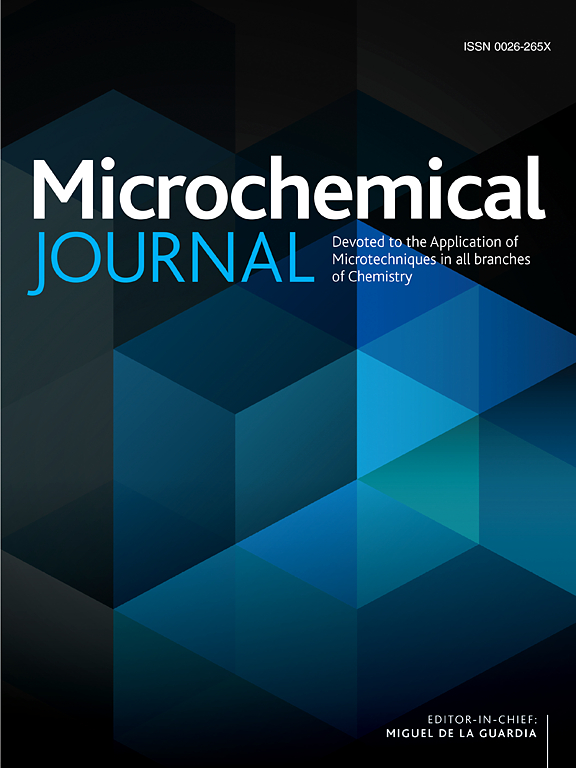Effects of in-situ leaching process on spatial distribution of soil properties in ion-type rare earth mines
IF 4.9
2区 化学
Q1 CHEMISTRY, ANALYTICAL
引用次数: 0
Abstract
In this study, an abandoned ionic rare-earth mine (MZ) was conducted in southern Ganzhou, China, to investigate the impacts of in-situ leaching mining techniques on the surface soil, with spatial characteristics analyzed from the mine’s bottom (MB), middle (MM), and top (MT) sections. The results revealed that, compared to the control area (CK), the soil in MZ exhibited significant reductions in pH, organic matter, and available potassium levels. Conversely, the concentrations of NH4+-N and SO42- in MZ soil were significantly higher than those in CK, being 55.58 and 1.36 times higher, respectively. The distribution pattern of rare-earth elements in MZ soil was consistent with that in CK, but at levels exceeding the background total rare-earth content of Jiangxi Province soils. Significantly lower concentrations of Zn, Pb, Cr, and Cd were observed in MZ soil compared to CK. Spatially, the organic matter content in MM and MT soils was significantly lower than in MB, while the NH4+-N content was significantly higher, being 10.55 and 7.86 times higher than that in MB, respectively. The pH of MT soil was significantly lower than that of MB, indicating the most severe acidification. MT soil also exhibited the lowest comprehensive fertility and the highest Nemerow comprehensive pollution index for non-rare-earth heavy metals. Consequently, the top region of MZ, three years post in-situ leaching mine closure, was identified as the most severely affected area by mining activities, with low soil fertility, residual leaching agents, and soil acidification posing the primary challenges in the abandoned mining area.

原位浸出过程对离子型稀土矿土壤性质空间分布的影响
以赣州南部某废弃离子稀土矿(MZ)为研究对象,从矿山底部(MB)、中部(MM)和顶部(MT)三个剖面分析了原位浸出开采技术对地表土壤的影响。结果表明,与对照区(CK)相比,MZ土壤pH、有机质和速效钾含量显著降低。相反,MZ土壤NH4+- n和SO42-浓度显著高于对照,分别是对照的55.58倍和1.36倍。MZ土壤中稀土元素的分布格局与CK基本一致,但超过了江西省土壤稀土背景总含量。MZ土壤中Zn、Pb、Cr和Cd的含量显著低于CK。从空间上看,MM和MT土壤有机质含量显著低于MB,而NH4+-N含量显著高于MB,分别是MB的10.55和7.86倍。MT土壤的pH值显著低于MB,酸化最严重。MT土壤综合肥力最低,非稀土重金属Nemerow综合污染指数最高。因此,在原地浸矿关闭三年后,MZ的顶部区域被确定为受采矿活动影响最严重的区域,土壤肥力低、浸出剂残留和土壤酸化是废弃矿区的主要挑战。
本文章由计算机程序翻译,如有差异,请以英文原文为准。
求助全文
约1分钟内获得全文
求助全文
来源期刊

Microchemical Journal
化学-分析化学
CiteScore
8.70
自引率
8.30%
发文量
1131
审稿时长
1.9 months
期刊介绍:
The Microchemical Journal is a peer reviewed journal devoted to all aspects and phases of analytical chemistry and chemical analysis. The Microchemical Journal publishes articles which are at the forefront of modern analytical chemistry and cover innovations in the techniques to the finest possible limits. This includes fundamental aspects, instrumentation, new developments, innovative and novel methods and applications including environmental and clinical field.
Traditional classical analytical methods such as spectrophotometry and titrimetry as well as established instrumentation methods such as flame and graphite furnace atomic absorption spectrometry, gas chromatography, and modified glassy or carbon electrode electrochemical methods will be considered, provided they show significant improvements and novelty compared to the established methods.
 求助内容:
求助内容: 应助结果提醒方式:
应助结果提醒方式:


